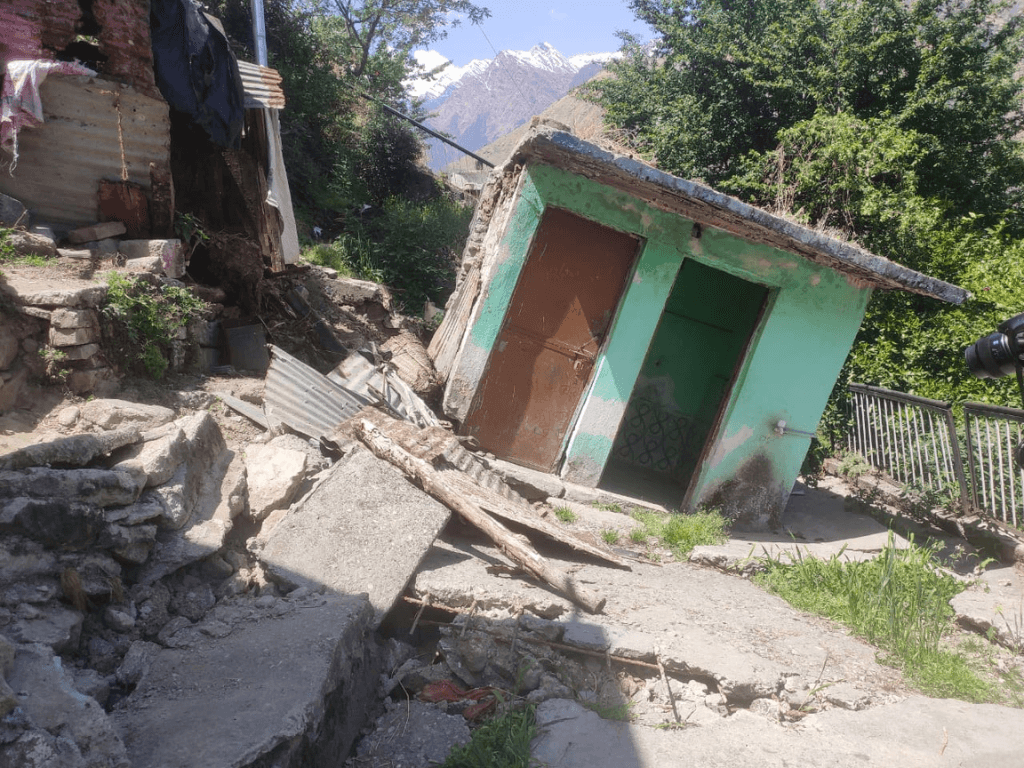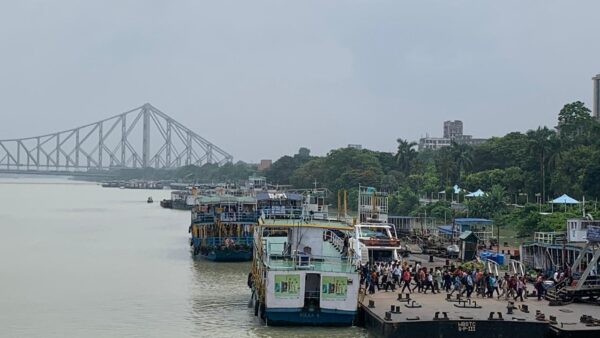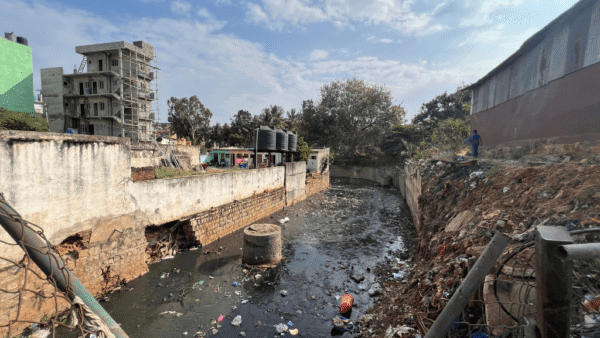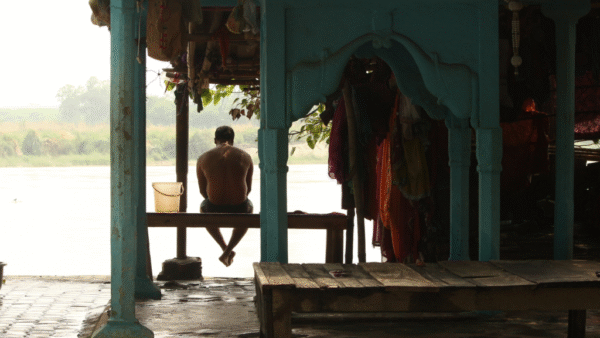This April 13 marked 100 days since residents of subsidence-hit Joshimath, in Chamoli district of Uttarakhand, began their protest. They stare at a bleak future for themselves and their town, many still living in temporary shelters, their lives totally upended by the land subsidence that began happening late last year. The protesting women are clear in their intent – they want safe homes, secure town and protected habitat. As the 60-year-old Nanda Devi of Singhar ward said, “This is a fight for home, also our struggle to save our habitat.”
The town of about 25,000 residents, and a destination for pilgrims and mountaineers-trekkers, sank by more than 14 centimetres – slowly from April to November last year, then a rapid subsidence of more than five centimetres in only 12 days in December-January. Around India, the land subsidence in Joshimath made news when it happened, but was soon overtaken by other events. In Joshimath though, it is an everyday worrying issue as houses show large and frightening cracks, people spend their days and nights with uncertainty and fear as their constant companions, and there is little clarity on what lies ahead. Recently, Uttarakhand Chief Minister Pushkar Singh Dhami said Joshimath was “completely safe and ready” for the Char Dham yatra. However, the reality is different, said the protestors.
As the town struggles to renew itself, the lesson it holds out is clear: Building a town without regard to its natural ecology has serious, often disastrous, consequences. It is a lesson, which environmentalists like Dr Ravi Chopra say (see interview) now holds out for other towns in the ecologically-fragile Uttarakhand where construction activity is in full swing and development projects disregard, by design or otherwise, the challenges of the terrain and its ecosystems.
The hazardous nature of undertaking massive construction in this terrain was well known. The 18-member MC Mishra Committee had warned, in its report in 1976, against rampant constructions because “Joshimath is a deposit of sand and stone, not rock”. From then to last year, more so in the last two decades, successive state governments and local authorities overlooked this and landslides while clearing a host of commercial and mega infrastructure projects. People here believe that the 520 MW Tapovan Vishnugad project and the Char Dham road project are the likely undoing of the town. Climate Change, manifesting here in frequent weather events, made matters worse.
“There is enough scientific evidence to show that the scale of the impact multiplied due to the massive commercial constructions in these regions. But the authorities and companies, while protecting their own interests, transferred the risks to local people,” said Ritika Thakur, volunteer with Youth For Himalaya, a socio-environmental group which has stood by the protesting residents in Joshimath and mobilised youth to demand justice.
Women have led the protest, sacrificing their wages and their domestic responsibilities, and have understood that the government has not yet declared it as a national disaster. This, according to many of them, has created deep-rooted issues and prolonged the trauma that their families faced in January. As many as 900 houses developed cracks making them hazardous to live in, 181 of these were tagged as “unsafe”. The women and activists demand compensation but also urge the authorities to save the sinking Himalayan town.
The pilgrim town ignored principles of nature
A devastating flood struck the region on February 7, 2021, after a part of Nanda Devi glacier broke off, killing more than 80 people. “We started noticing the cracks a year ago, in the aftermath of floods. But in December-January, the situation worsened,” said Rahul Kumar, 30, who runs an electric appliances and repair shop in Joshimath’s main market.
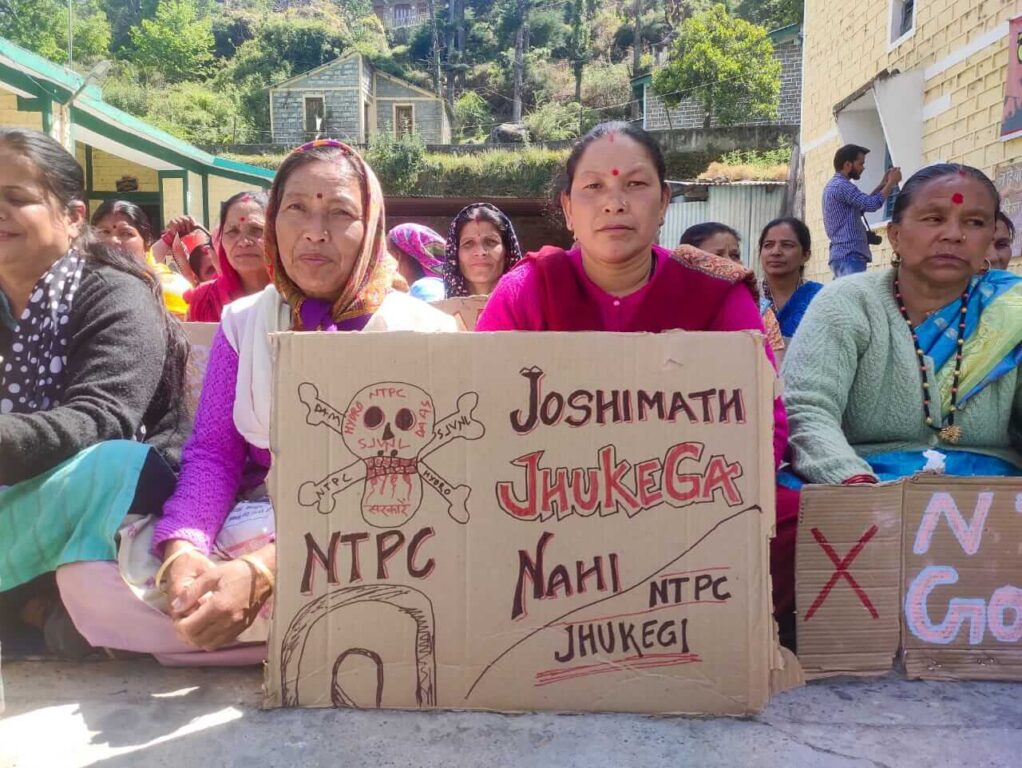
Photo: Sumit Mahar/ Youth for Himalaya
Joshimath, built at an elevation of 6,151 feet on an east-west ridge to the southwest of Vishnuprayag, the meeting point of the Dhauliganga and Alaknanda rivers, is a vulnerable geological region. The town was built on the debris of landslides and loose soil which is prone to slide and sink. Joshimath’s gneissic rocks are known to have a low cohesive value.
The town was built to also host a large number of Hindu pilgrims who visit its many temples such as the Hanuman Mandir, Gaurishankar Temple, Ganesh Temple, Naudevi Temple, and Surya Temple. The Kalpavriksha tree, believed to be around 1,200 years old, is an attraction too. The town is also a base for mountaineers and pilgrims travelling to Badrinath. In 2021, both towns saw a combined tourist footfall of 3.5 lakh, over 10 times the population of the Joshimath (Census 2011).
“The urbanisation of Joshimath started long ago,” said Atul Sati, convenor of Joshimath Bachao Sangharsh Samiti. “Years ago, Joshimath used to be a ‘mandi’ (big and open marketplace) and its residents were active participants in the commerce.” Ancient trade routes connected Tibet and China with Uttarakhand, India, through the Mana Pass. Sati said an agreement between China and India to allow pilgrims and native travellers to pass via Mana Pass was signed on April 29, 1954, after which urbanisation picked up pace.
His father used to tell him how thousands of cattle used to stay on their land in the summer nights when herders used to migrate to the upper ranges of Himalaya. “As the cattle used to be on our agricultural land, decomposing of the excreta during the nights was the main source of fertilizers for our agricultural lands,” Sati recalled.
Unsustainable growth
When trade and commerce grew, the people of Joshimath started shifting from agriculture to business. “Indigenous people started to sell their lands to commercial builders and governments; some people moved to businesses; some set up small tea stalls and resting places for pilgrims,” explained Sati. The town expanded – or was built – but without much thought or concern to the environment and local ecosystems.
The unplanned growth of Joshimath to cater to the increasing footfalls led to huge destruction of its natural areas, putting immense pressure on its already fragile landscape. It became an over-built town on shaky ground. “One of the main reasons for the intense activity in the mountains is the push for development by the governments, notably after the 1990s and particularly when Uttarakhand became a state,” Sati added.
Fifty-six years old Prem Singh Budha has seen the changes since 1976 when he left Nepal and came here for work. “The greenery is lost,” says Budha, who worked as a labourer till 2007 when he opened a tea shop. A family of five, Budha’s son, Viru who was born in Joshimath said, “We have decided to go back to Nepal.” Affected people were moved to government shelters, but that is hardly enough to address people’s anger and fear.
Anita Lama, 37, an Aanganwadi teacher, and her family had to shift out of their house, after it developed huge cracks. For weeks, they lived out of a hotel room but the hotel building too developed major cracks and was flagged unsafe. “Last year’s flood in which around 150 people went missing, mainly migrants from Nepal, was an alarm. If they see inside the tunnel where the flood water and debris are still there, they might find the bodies,” she said.
Although there are natural factors linked to the sinking of Joshimath, “the man-made factors, including the rapid urbanisation and heavy construction aggravated the tragedy,” said Indresh Maikhuri, 45, activist, who joined the protest every day and organised the people to agitate. “The model of development is a big threat to the ecology of the Himalayas.”
The widespread damage is attributed here to a series of development works, most specifically the tunnelling for the Tapovan Vishnugad Hydroelectric Plant by the National Thermal Power Corporation (NTPC) though the company has denied it. There are, in all, 42 operational hydropower projects in Uttarakhand – this alone should provoke reflection of the impact on the ecology.
The rapid rate of land subsidence in Joshimath has significant impacts on the future of not only Joshimath town, but also adjacent regions and its people. Increasing risk of flooding, damage to infrastructure and buildings, loss of ecology and reduced economic viability are some of the threats. “More than that is the fear of being washed away,” says Maikhuri.
More ‘Joshimaths’ possible
Like the December 2004 tsunami which rocked southern India, Uttarakhand faced continuous heavy rains in 2013 which battered life and property in several areas where torrential waters from the Himalaya swept away roads, bridges, houses, and structures in the churning waters.
In the study Orographic control of the Kedarnath Disaster by researcher AS Ningreichon and three others, they concluded that four regions — Kedarnath, Ukhimath, Joshimath and Badrinath — were the worst-affected in the 2013 tragedy. The researchers mention a boundary which demarcates the areas of high and low precipitation in the Garhwal Himalayas.

Photo: Hemu Awasthi/ Youth for Himalaya
“During the monsoon season, the areas of Kedarnath, Badrinath, Joshimath, Bhatwari, etc. lie on the windward side and hence receive more precipitation compared to the areas of the extreme north and those at higher altitudes. The orographic effects in these areas are the major contributing factors which created such devastation. The landslide data from the Geological Survey of India also indicate that activities like landslides, slumping and sinking of the ground happen in these areas”.[1]
Such topographic elements, frequent natural calamities, and the impact of Climate Change together pushed Joshimath – and the region – to the brink even as the town was rapidly expanded. Can there be more ‘Joshimaths’ here? Many here, locals and environmentalists, say these are disasters waiting to happen – the price of rapid construction-led development.
Warnings go unheeded
The warning bells had been sounded when the Mishra Committee report, in 1976, had warned about the grievous situation but was mostly ignored. “Joshimath is a deposit of sand and stone – it is not the main rock – hence it was not suitable for a township. Vibrations produced by blasting, and heavy traffic will lead to a disequilibrium in natural factors,” the report stated.
However, this did not stop the growing urbanisation, heavy constructions at a rapid pace, and immigration in Joshimath and neighbouring regions of the Himalayas. Nanda Devi Biosphere Reserve is only 5 kilometres downstream from the NTPC’s Tapovan Vishnugad Project. The use of explosives for the project caused the animals from the Reserve to flee and enter villages, disturbing the biodiversity cycle and making it hazardous for people.
As footfalls grew in Joshimath and presented bigger business opportunities, so did urbanisation bringing the needle back to the debate of economics over environment.

Photo: Shadab Farooq
Environmentalist Ravi Agarwal, 62, opined that the extent of such disasters is not limited to Joshimath. “The Himalayas are the youngest mountains and too fragile. The mountain range is moving with a tectonic motion,” he said. Although major constructions have stopped now, the so-called development projects should have been stalled a long time ago. The response of the authorities to the several warnings and signs has been pathetic, leading to destruction of natural resources.
Jinal Jain, pursuing his Masters in Disaster Management at Tata Institute of Social Sciences, Mumbai, has studied Joshimath. The disaster, according to him, has entered the response phase where the government has only limited options — to evacuate people and triage places. “Our development is just reflexive not reflective. It is high time we implemented alternative developmental approaches in harmony and sync with nature,” said Jain.
That sinking feeling remains
Panic grips the residents of Joshimath as they see helicopters descend on the town with survey teams, assessing and marking the areas. People here have their own ways of ascertaining the disaster, many linked it to the rampant cutting or blasting of mountains. Fifty-year-old Jot Singh Rawat, who has a paan shop near Nanda Devi Hotel, has lost all hopes of rehabilitation. Staring at his house slowly sinking, he rued, “This is man-made karma.”
The authorities halted heavy construction work, including the dam project, in the wake of the land subsidence. But that is hardly solace to either nature or people. Nature cannot simply and immediately restore its balance. Now, the tragedy is starkly human – Viru Budha in a hurry to sell his scooter and other belongings so that he can go back to Nepal, Lalita Devi wondering how long she and her family have to live in the Kali Kamli Dharamshala, Raghav who was forced to move to Nandprayag 60 kilometres away, and Nanda Devi who has been sitting at the protests every day without fail to fight for her home – and her habitat.
“We wait for the compensation but we are scared to even sleep. What if we are under the debris in the morning,” asked Lalita Devi.
Shadab Farooq is an independent journalist based in Delhi and reports from Kashmir, Uttarakhand and Uttar Pradesh. He writes on politics, culture and the environment.
Cover photo: Sumit Mahar/ Youth for Himalaya

